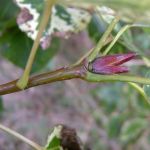| Common Name: |
Canadian Poplar |
| Other Names: |
Balm of Gilead, Ontario Poplar |
| Botanical Name: |
Populus x candicans syn. P. x gileadensis, P. x jackii (P. balsamifera x P. deltoides) |
| Genus: |
Populus |
| Family: |
Salicaceae |
| Location: |
N America |
| Cultivation: |
Deep, moist, well-drained soil in sun. Poplars have extensive root systems and should not be planted close to buildings or drainage systems. Prone to bacterial canker and fungal diseases. Aphids, poplar beetle larvae, and caterpillars may attack leaves. Populus alba tolerates drier conditions than most poplars. Prune P. x candicans 'Aurora' hard in late winter to encourage vigourous shoots and colorful new leaves. |
| Propagation: |
By hardwood cuttings in winter; by removing suckers in autumn or winter. |
| Harvest: |
Buds are collected in spring before opening (P. x candicans), and dried for infusions, liquid extracts, and tincture. Bark is stripped from side branches or coppiced trees, and used dried for decoctions, liquid extracts, and powders. |
| Height: |
15-25m (50-80ft) |
| Width: |
6m (20ft) |
| Variations: |
Aurora
Has conspicuous new leaves, irregularly variegated creamy-white, and often pink-flushed, which age to green |
| Hardiness: |
Z3-8 |
| Parts Used: |
Leaf Buds |
| Properties: |
An antiseptic, anti-inflammatory, expectorant herb that lowers fever, stimulates the circulation, and has antibacterial and antifungal effects. Applied topically, it relieves pain and improves blood flow to the area. |
| Medicinal Uses: |
Internally for bronchitis and upper respiratory tract infections. Externally for colds, sinusitis, arthritis, rheumatism, muscular pain, psoriasis, and dry skin conditions. Widely used in cough mixtures, often with Pinus strobus (See, Scots Pine) and Prunus serotina (See, Wild Black Cherry). |
| Economic Uses: |
Dried buds are added to potpourris |
| Warning: |
Not given to patients allergic to aspirin.
Not prescribed to nursing mothers. |
| Bibliography: |
Encylopedia of Herbs by Deni Brown Copyright ©: 1995, 2001 Dorling Kindersley Limited pp.327-328
|
